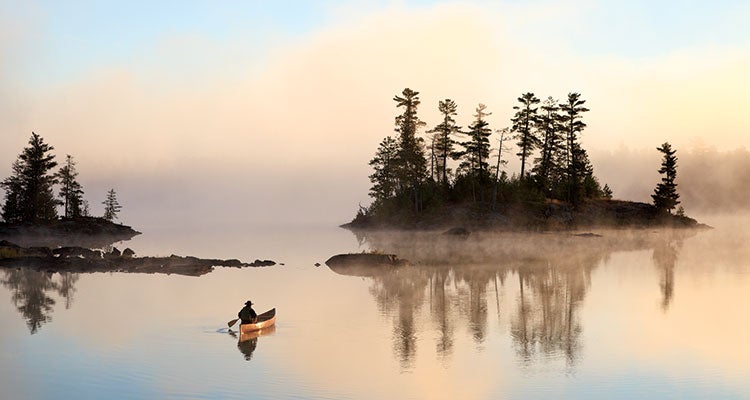Do the Boundary Waters Right

'Get an early start to take advantage of calmer conditions in Boundary Waters. Photo by RadiantSpiritGallery.com'
Years from now, Abby will chuckle at the father-daughter “bonding” we enjoyed on Ogishkemuncie Lake in the Boundary Waters last September. As Minnesota’s late-afternoon winds turned a mild rain squall into survival-mode canoeing—with horizontal hail and 4-foot whitecaps—my earlier insistence on fishing just a little bit longer was starting to look like another one of dad’s overambitious miscalculations. We’d enjoyed a successful day hunting walleye, smallmouth, and northern pike with our group of four, but now faced miles of open water to reach camp, an effort that felt as long and arduous as the big lake’s tongue-twister of a name.
Our camp sat atop a small, steep-sided island in the middle of Ogish, which itself sits almost dead-center in the Boundary Waters Canoe Area Wilderness. Ground zero for paddlers, the million-acre labyrinth hosts the densest concentration of lakes in America—making it the obvious choice for another remote canoe trip. My childhood friend James and I have been engineering float-and-fish adventures every five years since our twenties. For this one, though, we decided to bring our kids—my younger daughter, his older son—as a means of passing the wilderness torch.
The torch was nearly extinguished in that squall, but in storybook fashion the storm suddenly broke and a rainbow materialized directly over our island, as if pointing the way home to our very own North Woods Shangri-La. Within minutes, the waves on Ogish gave way to a glassy surface so still that in unison we stopped paddling to soak in the magic. This is why we’d come.
We returned to camp—set on a breezy promontory for excellent views, mosquito control, and privacy—with a dinner’s worth of pike and bass on each of our lines. At sunset, the lake echoed with the call of loons. The mature forest that surrounds it was starting to pop with spectacular autumn hues. Earlier, moose had grazed knee-deep in marshy areas along the banks, and otters had interrupted their hunting for curious glances at our canoes. It was as if every canoe-tripping fantasy I’d ever had was coming true.
As we hauled our boats out of the water back at Seagull Lake, completely relaxed and a little sunburnt from 10 days on open water, Abby slung an arm over my shoulder. “Dad,” she said, “let’s do this again next summer. And let’s stay just a little bit longer.”
DO IT To do Ogish right, you need eight to 10 days. Set out from Seagull Lake (48.157297, -90.893669; a five-hour drive north of the Twin Cities via I-35 and Gunflint Trail) and paddle-and-portage your way southwest (about 9 miles as the crow flies). Season Summer for best temps and fall for foliage and fewer bugs Gear up Seagull Outfitters (seagulloutfitters.com), right at the put-in Permit Required; reserve six months in advance at recreation.gov (starting at $16 per person). Contact